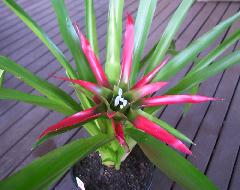
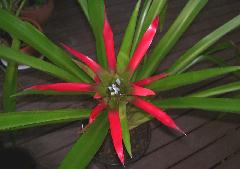
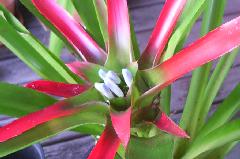
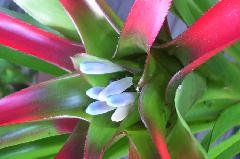
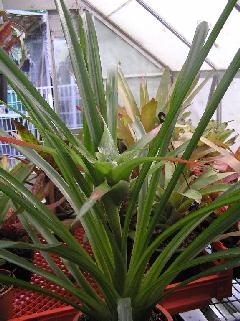
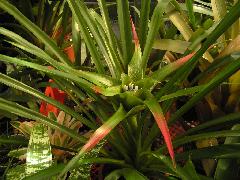
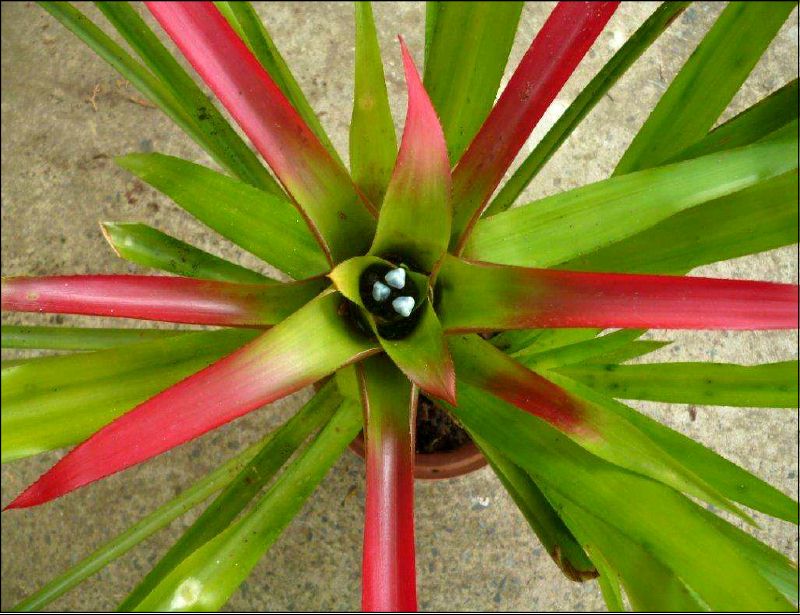
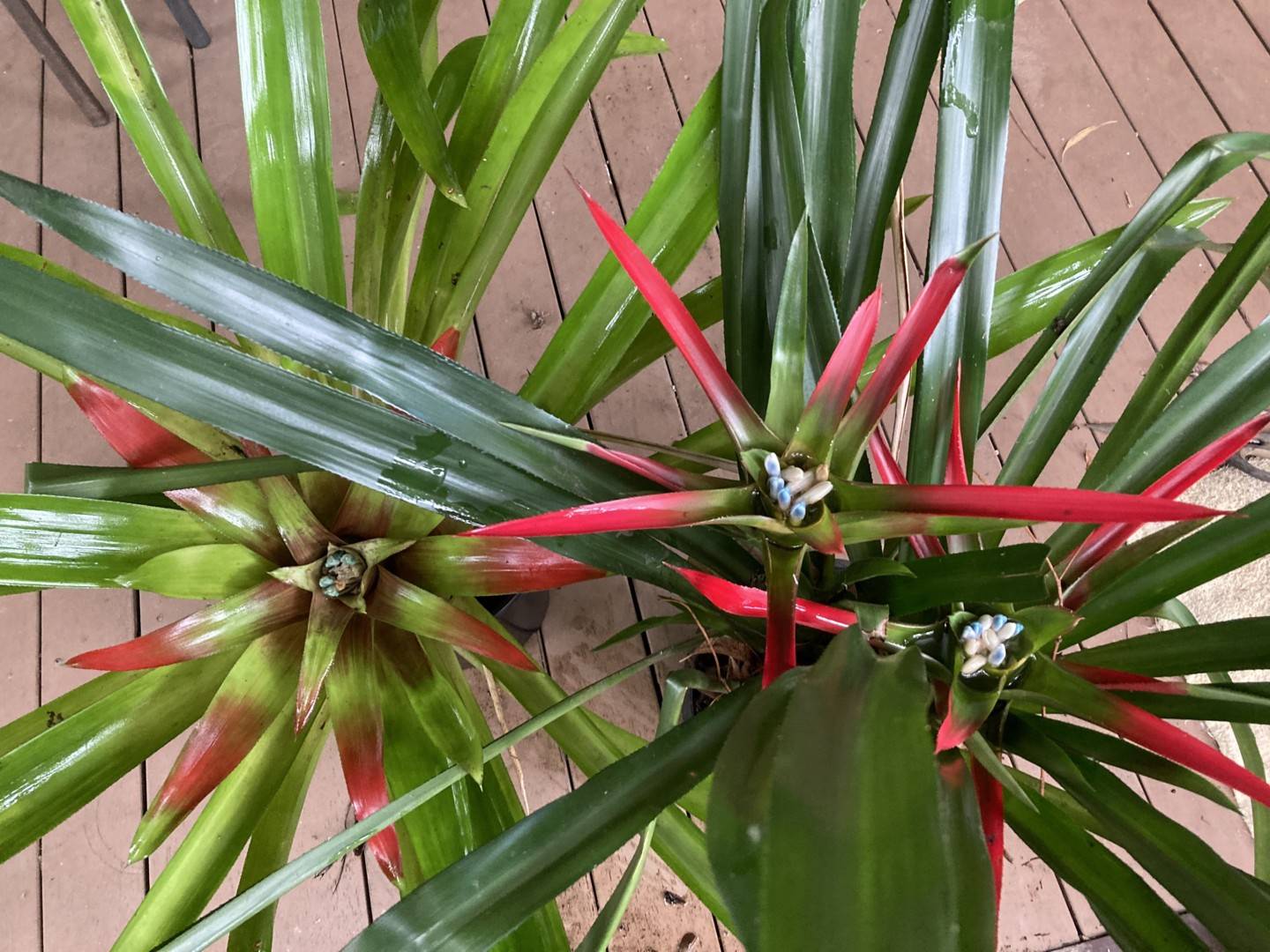
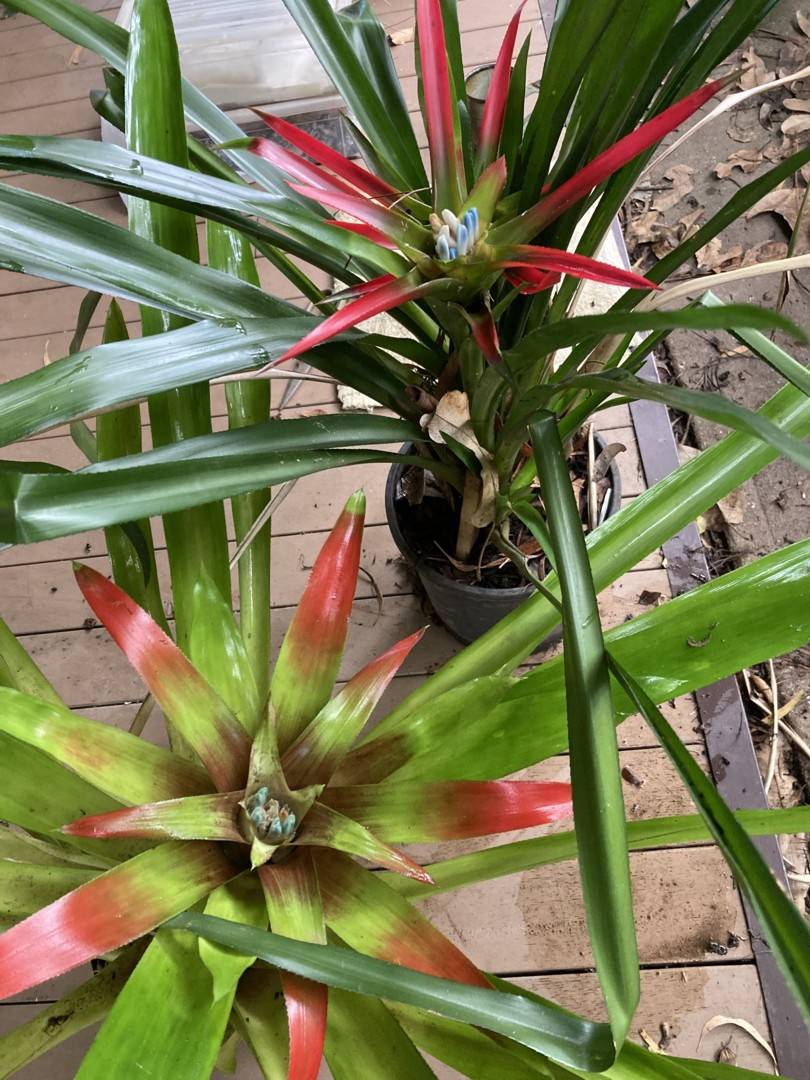
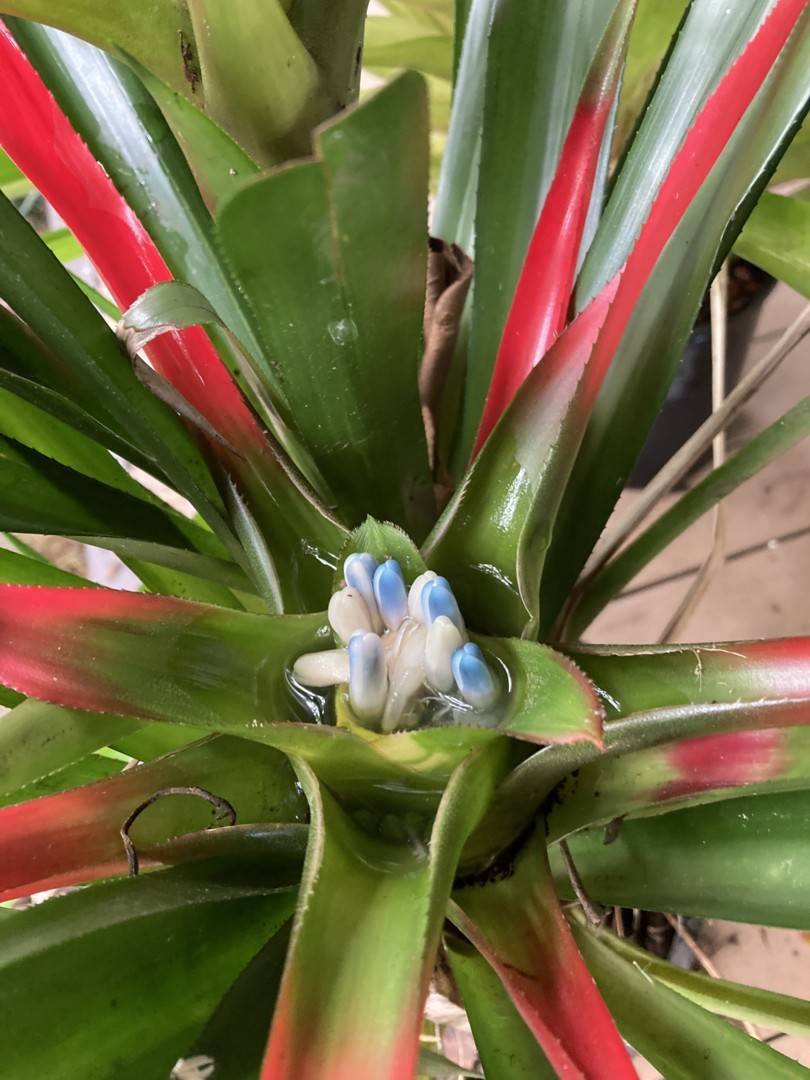
LEAVES ca. 15, suberect, torming a narrow funnelform rosecte;
SHEATHS narrowly oblong, 15-17 x 4- 7 cm, greenish, subdensely brown-lepidote;
BLADES sublinear, slightly narrowed toward base, 30-60 x 1.5-3.5 cm, green, glabrescent adaxially, sparsely lepidote abaxially, subchartaceous, apex slightly recurved, acuminate, margins densely to sub densely spinulose, spines 0.5-1 mm long, 3- 7 mm apart.
SCAPE 22-25 cm long, ca. 0.6 cm in diameter, distinctly exceeding the leaf sheaths, covered by the scape bracts, sparsely lepidote;
SCAPE BRACTS the basal ones foliaceous and exceeding the inflorescence, the upper ones subfoliaceous.
INFLORESCENCE bipinnate, long-stellate at apex, ca. 7 cm long, 13-20 cm in diameter at apex;
PRIMARY BRACTS 13-15 cm long, with a distinct broadly ovate to suborbicular sheath, 4.5-6 x 4.5-6 cm, and a narrowly triangular-lanceolate blade, ca. 2.5 cm wide at base, apex acuminate, spreading, slightly ascending toward apex, almost completely green to red at apex, inconspicuously lepidote toward base, densely and conspicuously spinulose toward apex, spines ca. 1 mm long;
FASCICLES ca. 9, the lower ones ca. 4-flowered, ca. 40 x 20 mm;
FLORAL BRACTS ovate, apex acute and apiculate, sub densely to very densely and distinctly spinulose at apex, spines irregularly curved, rarely entire, 23-30 x 9-13 mm, sparsely brown-lepidote, greenish near the apex, hyaline elsewhere, about equaling the middle of the sepals.
FLOWERS subsessile, 40-60 mm long, slightly fragrant;
SEPALS obovate to oblong-elliptic, apex broadly acute to rounded and minutely apiculate, 22-25 x 7-9 mm, connate for 5-6 mm, sparsely lepidote inside, green;
PETALS 35-40 mm long, connate for ca. 24-30 mm, tube white, lobes 10-11 x 6 mm, blue to bluish-white at anthesis, becoming whitish after anthesis, bearing 2 inconspicuous callosities at base;
ANTHERS 9-10 mm long, apex apiculate;
STIGMA ellipsoid, blades with margins minutely crenulate;
OVARY subclavate, ca. 15 mm long, ca. 7 mm in diameter.
FRUITS white toward base and brownish toward apex, persistent calyx greenish-yellow to yellow.
TYPE. Rio de Janeiro State, Rio de Janeiro City, Cascadura, Serra da Bica, Jul. 1896, E. Ule 4039 Holotype. B.
DISCUSSION
Nidularium angustifolium was described in 1898 by Ernst Ule who provided only a brief description of the species in the protologue and named the collection site ("Serra da Bica"). He did not even include his collection number as was the custom and contrary to his usual style. Mez (1935) accepted the species as valid and gave a much more detailed description than the original one. He designated specimen Ule 4039 from Serra da Bica as the holotype. Two decades later, Smith (1955) considered N. angustifolium to be a synonym of N. procerum, and this was maintained in Smith & Downs (1979).
The description of N. viridium as different from N. procerum paved the way to recognizing N. angustifolium as a distinct taxon. After analyzing the type species based on specimen Ule 4039, collected at Serra da Bica and deposited in the herbarium of the Botanical Museum in Berlin-Dahlem (B), as is mentioned in the protologue, it became obvious that N. angustifolium was identical to N. viridium. The flower-color pattern in N. viridium represents just one extreme for this species - apparently an almost total lack of anthocyanin. The decision to place N. viridium in synonymy also made it possible to recognize N. angustifolium as a species distinct from N. procerum.
Nidularium angustifolium is clearly related to N. procerum. It differs from the latter in its lax, long-pointed, stellate inflorescence, primary bracts red (usually) only near the apex, long-acuminate and spreading-ascendant toward the apex, sepals obovate with wide-acute to rounded apex, ovary white, as are the fruits, with a greenish yellow to yellow persistent calyx. There is an interesting color variation in this species. At one extreme are plants with totally green bracts and white or bluish white petals, a pattern that is compatible with the description of N. viridium. In contrast, at the other extreme are plants with almost totally red primary bracts and blue petals with white margins. The average pattern, however, is shown by plants that have primary bracts with the apical 1/3 red and blue petals with white margins.
DISTRIBUTION & HABITAT
Nidularium angustifolium is endemic to Rio de Janeiro state. Its northern geographic limit is the city of Rio de Janeiro as registered by the historical collections of E. Ule and A. Glaziou. Serra da Bica is located in the suburb of Cascadura that lies in the heart of Rio de Janeiro. There are no vegetation fragments here that might be home to this species. Today, N. angustifolium populations are more common in southern Rio de Janeiro, where this plant lives on the forest floor or as an epiphyte in the lower layer of the Atlantic slope forest, at altitudes of 50 to 500 m. A single collection (Seidel 756) of this species was recorded in Parana, very probably an involuntary oversight by the collector as the result of an inaccurate collection-data control system.
This species apparently flowers at two different times of the year, one from January to March and the other from July to September. The species does not occur in any public conservation unit. About four different clones of N. angustifolium are available in cultivation.
Nidularium viridium E Pereira & Leme, Bradea 4 (22). 153, fig. 3.1985.
PLANTA terrestris, florifera ca. 75cm alta, foliis ca. 15 suberectis rosulatis, 50-75cm longis, ligulatis, basi utriculum anguste infundibuliformem efficientibus.
VAGINIS sublinearibus ca. 15cm longis, ca. 5cm latis, interne viridibus, externe viridibus sed basim versus brunneis, utrimque subdense albo-lepidotis, squamis integris;
LIMBIS ca. 60cm longis, latitudine ut maxima 2,5cm, utrimque viridibus atque subglabris, transversaliter virido-lineatis, basim versus angustatis canaliculatisque, apice acuminato et apiculato, apiculo ca. 5mm longo, foliaceo, margine subdense serrulata, spinis 0.5mm longis, 5-l0mm inter sese distantibus.
SCAPUS ca. 25cm longus, in vivo 6mm diam., sulcatus, sparse albolepidotus, vaginum foliorum valde superantibus;
BRACTEIS SCAPALIBUS foliaceis, inflorescentiam valde superantibus, scapum omnino accultantibus,
INFLORESCENTIA stellata, ramis breviter pedunculatis, flabellatis, ca. 4 floribus;
BRACTEIS PRIMARIIS ca. 9, large ovatis, sparse albo-lepidotis, ca. 7cm longis, 6cm latis, limbis peranguste triangularibus, subglabris, 13cm longis, subdense serrulatis, utrimque viridibus, transversaliter virido-lineatis, suberectis vel interdum apicem versus leviter purpurascentibus atque recurvatis, apice acuminatis apiculo foliaceo 4mm longo de-sinentibus;
BRACTEIS FLORIFERIS ca. 23mm longis, 9mm latis, oblongo-lanceolatis, apice acuto apiculatoque, prope apicem parce serrulatis, carinatis, curvatis, externe sparse albo-lepidotie, viridibus, sepalorum medium aequantibus.
FLORES ca. 6cm longi, inconspicue pedicellati;
SEPALIS oblongo-obovatis, 22mm longis, 7mm latis, apice large acutis atque apiculatis, viridibus, glabris, obtuse carinatis, basi 6mm connatis, sub-symmetris;
PETALIS albis, base in tubum ad 30mm longum connatis, lobis l0mm longis, apice obtuso-cucculatis;
STAMINIBUS inclusis, filamentis in tota longitudinem tubo adnatis;
ANTHERIS 9mmu longis, linearibus, basi rotundatis, apice mucronulatis, medium dorsifixis;
OVARIO obovato, ca. 15mm longo, 5-6mm diam., trigono, albo, glabro;
TUBO EPIGYNO ca, lmm longo,
PLACENTIS medium usque ad apicem loculorum affixis.
OVULIS obtusis.
TYPUS: Rio de Janeiro, regiao entre Mangaratiba e Passa Tres, ca. 400msm. Planta florida em cultivo em 31/03/1985. Leg. Luiz Correia Araujo s/n.
HOLOTYPUS: HB no 72-138, ISOTYPUS: RB.
Esta nova especie e afim de N. procerum Lindman, do qual difere, principalmente, pelas bracteae primarias totalmente verdes, sepalas oblongo-obovadas, com o apice largamente agudo, e pelas petalas brancas.
This new species fits near to N. procerum Lindman, differing from it mainly in its green primary bracts, the oblong-obovate sepals with a broadly acute apex, and the white petals.